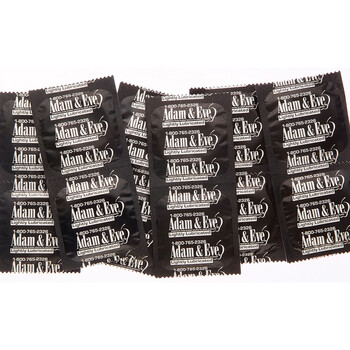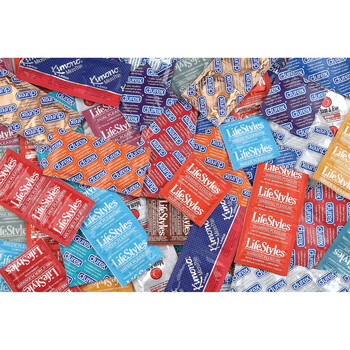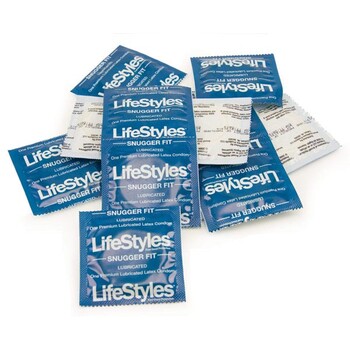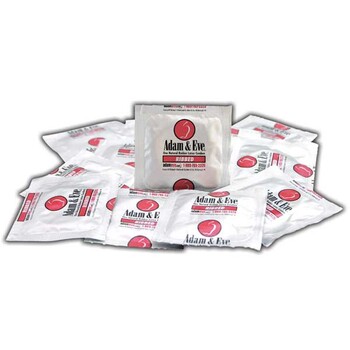What Does Safer Sex Mean?
How Do Condoms Work?
Common Condom Myths
Shopping for Condoms
How to Use a Male Condom
Other Popular Birth Control Methods
Adam & Eve started in 1971 selling condoms by mail, and they remain an important part of the company’s business even 50 years later. According to their records, Adam & Eve has sold 14 million condoms over the years… and probably given away even more! Since the average American couple has sex 54 times a year, that’s enough condoms to keep everyone in Las Vegas rocking for an entire year.
Condoms themselves have been around for a lot longer than 50 years. Historians can trace them all the way back to 3,000 BC. Those early condoms were originally made from a wide variety of materials, including animal intestines, leather, and linen. Rubber condoms started appearing in the mid-1800s and quickly become popular around the world as a reliable method for safer sex.
What Does Safer Sex Mean?
Aside from masturbation, there’s no such thing as completely safe sex. Even when you do everything correctly, there’s always a certain amount of risk associated with having sex. That risk might be becoming pregnant if a condom breaks during sex or running into a problem with birth control pills. It could be contracting a sexually transmitted infection (STI) from unprotected oral sex or a cheating partner.
Safer sex involves reducing your chances of becoming pregnant or contracting a STI while still allowing you to enjoy sex. Many people practice safer sex every day simply by choosing sexual exclusivity with their committed partner. Others might rely on outercourse (body grinding), masturbation, or abstinence to protect themselves. If those aren’t options for you, then the best thing you can do is minimize the transfer of body fluids as much as possible. The most effective way to do that is with a condom.
How Do Condoms Work?
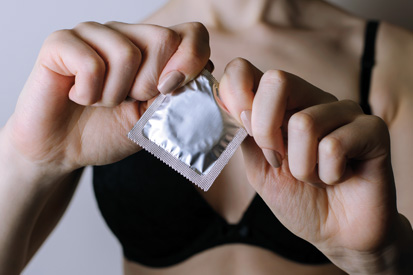
Condoms are thin tubes that fit over the penis (in the case of male condoms) or inside the vagina (for female condoms). This creates a barrier preventing the two partners from exchanging body fluids, including vaginal secretions, pre-ejaculate, semen, and even blood.
It’s important to note that condoms aren’t foolproof by any means. According to Planned Parenthood, condoms are 98% effective at preventing pregnancy – but only when used perfectly. Since real life is anything but perfect, condoms are around 85% effective.
Where condoms really shine is protecting you from STIs. No other birth control method provides protection against HIV, chlamydia, gonorrhea, and other infections. The effectiveness of condoms depends on accurate use and avoiding user error. Condoms are less effective when it comes to herpes and HPV, which can be spread from skin-to-skin contact.
Common Condom Myths
Condoms aren’t something that people talk about a lot, which leads to all kinds of misconceptions and flat-out incorrect information. Here are some of the more common condom myths I’ve heard from my patients:
It’s the man’s/woman’s responsibility to carry condoms.
I’ve heard both sides over the years, and they’re both wrong! Condoms (and birth control in general) are the responsibility of BOTH partners. The entire burden shouldn’t fall on one person’s shoulders. If you’re thinking about having sex, then it’s your responsibility (regardless of your gender identity) to pick up some condoms.
Wearing two (or more condoms) makes you even safer.
This actually makes you less safe! If you wear multiple condoms at the same time, they’re more likely to rip during sex.
I don’t need to use condoms for oral sex.
While you won’t get pregnant from oral sex, there are several STIs (including gonorrhea and chlamydia) that can still be spread orally. Condoms can help protect you from those. Adam & Eve even offers flavored condoms specifically for oral sex. Their Flavored Condom Sampler comes with 50 different condoms and a wide assortment of tasty flavors like grape, mint, strawberry, and more to make your oral experience even sweeter.
We’re on the pill, so we don’t need condoms.
There are actually two things wrong with this statement. First, the pill doesn’t provide any protection from STIs. Secondly, no single method of birth control is 100% effective. I strongly recommend using at least two methods, preferably a condom and another method such as birth control pills.
Guys should always carry a condom in their wallet.
Carrying a condom with you is smart advice. The problem is that your wallet is one of the worst places to keep it. Condoms need to be stored at room temperature. Your wallet presses against your body all day long. All that body heat weakens the condom, especially after carrying it around for a few months. This makes the condom much more likely to break during sex.
I always use condoms – I just wash them after every use.
This was a pretty common practice… a hundred years ago. Modern condoms, however, are disposable. You should throw them away after each use. You should also never use the same condom with multiple partners. And, just to cover all the bases, you shouldn’t turn the condom inside out and use it again.
Shopping for Condoms
Adam & Eve once asked people if they were comfortable with buying condoms. A shocking 38% of men and 15% of women said they were embarrassed to buy them. Let me state emphatically that there shouldn’t be anything embarrassing about condoms. They represent smart and responsible decision-making. They’re something that almost everyone buys at one point or another.
That being said, we can’t control our feelings. If buying condoms makes you feel embarrassed or uncomfortable, there are some things you can do to minimize those feelings while still making the responsible choice to use condoms. Many stores today have self-checkout lanes, so you can ring up the condoms without having to make eye contact or small talk with anyone else. You can also buy condoms online at Adam & Eve without anyone knowing. They’ve got a terrific selection of male condoms, including samplers so you can try different types!
When shopping for condoms, it’s important to keep a few things in mind:
Material – Latex or Non-Latex
Most condoms are made from latex rubber. While this works fine for many people, it doesn’t work very well for people with latex sensitivities and allergies. Even if you don’t have any problems with latex, your partner might. If so, you’ll need to use non-latex condoms. These condoms are typically made from polyurethane, lambskin, or polyisoprene. While lambskin protects against pregnancy, it doesn’t protect you from STIs. That requires polyurethane or polyisoprene.
Sizing
The average condom is made for the average-sized penis. If you or your partner is bigger than average, then it will take a larger-sized condom to provide the protection you both need. Don’t buy larger condoms unless you really do need them. If the condom’s too big, it can slip off easily during sex.
Pre-Lubed
Most condoms today come pre-lubed. If you’re trying to decide between lubed and non-lubed, then definitely go with the lubed. It’s just easier to use and works better.
Stimulation Options
Modern condoms do a lot more than just provide protection. With the right options, you can use them to enhance your sex life too. In addition to the flavored condoms for oral sex I talked about earlier, you can find others with ticklers and teasers for extra stimulation. Some condoms use warming or stimulating lubes for extra pleasure. Many condom brands offer a special thin version to feel more natural.
If you don’t like using condoms, you probably just haven’t found the right one for you. Adam & Eve offers a lot of different condom options that you can't find anywhere else. You probably just haven’t found the right condom for you!
How to Use a Male Condom
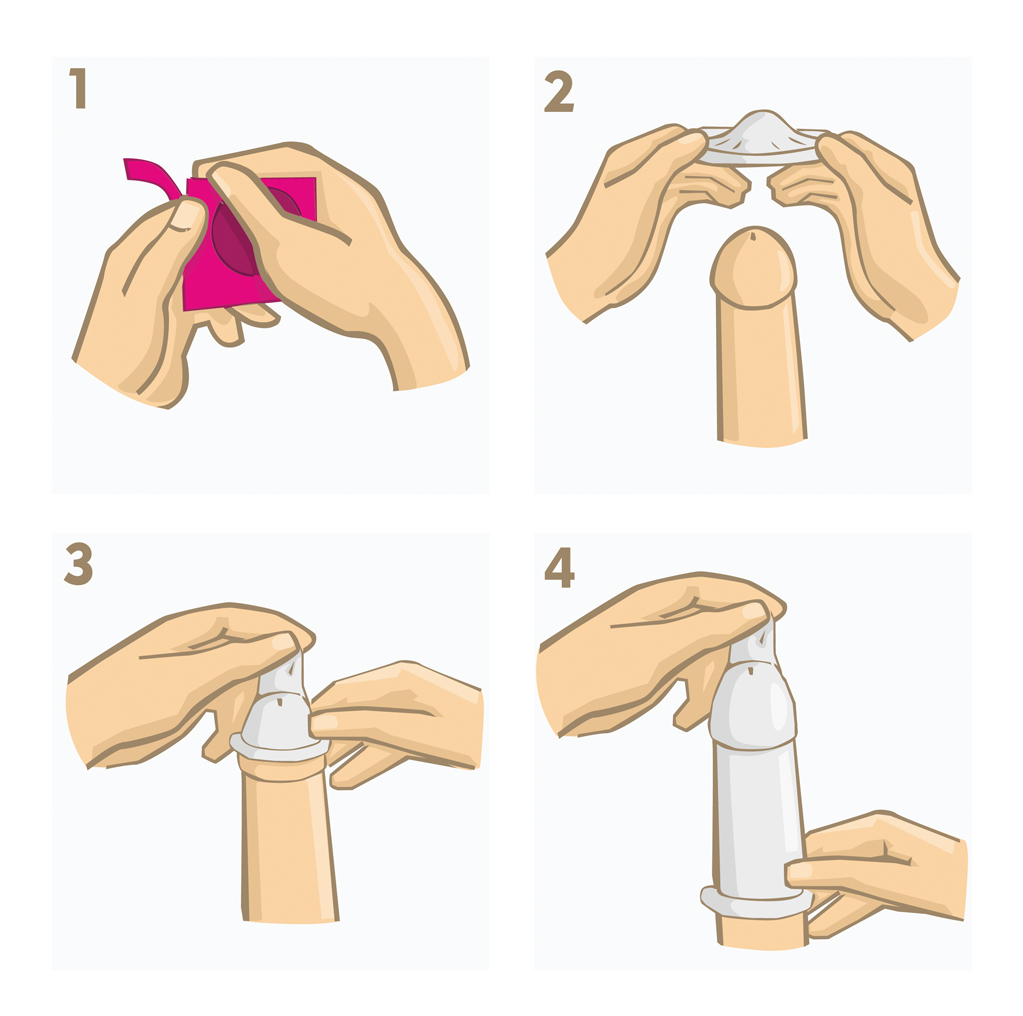
To maximize your protection while using a condom, you need to put it on correctly. Thankfully, condoms are pretty user friendly (even with 90% of your brain focusing on your sexy partner) if you follow these four basic steps:
- Carefully open the foil package – without tearing or stressing the condom itself. Don’t use your teeth or scissors. It might look cool, but you’re much more likely to damage the condom. It also pays to double-check the expiration date.
- Position the condom so that the rim is on the outside with the tip pointing up. (It should look like a little beanie.) Pinch the tip of the condom with your fingers and center it over the tip of the penis. This creates some extra space to collect semen and prevents any air bubbles from forming.
- If your condom isn’t pre-lubed, you should apply a few drops of either water-based or silicone-based lube to the penis tip and upper shaft. Be careful not to use too much or the condom could slip off.
- Slowly unroll the condom down the shaft to the base of the penis. Then let the sex begin!
It’s important for the partner wearing the condom to occasionally check it during intercourse. Condoms can slip off or tear, and this can help prevent any problems before they occur.
After you’re done having sex, you’ll need to remove the condom – without spilling anything. This part of the operation is just as important as putting a condom on. It’s generally easier for the person wearing the condom to remove it. Here are some tips for taking the condom off:
- After you ejaculate, grab the rim of the condom at the base of your penis. Some men quickly lose their erection after climaxing. This prevents the condom from slipping off.
- Pull out of your partner slowly and steadily while continuing to hold the rim of the condom.
- Once your penis is all the way out, point your shaft downward and start sliding the condom off. Pinch the condom below the semen reservoir to prevent spilling and continue removing the condom.
- Once the condom’s off, tie it in a tight knot and throw it away. (Condoms are not biodegradable so you shouldn’t flush them down the toilet.)
- Wash your penis with warm, soapy water to clean off any remaining lube or semen.
Other Popular Birth Control Methods
Male condoms are just one of many birth control methods available. Some of them are even better at preventing pregnancy. Most of those alternatives, however, don’t provide protection against sexually transmitted infections. Here’s a brief overview highlighting some of the most common birth control methods.
IUDs
An intrauterine device is inserted into the uterus. It physically blocks sperm cells from reaching the egg. When inserted correctly, IUDs are 99% effective, and they can be used safely for years at a time. If you want to become pregnant, you can simply remove it.
Birth Control Pill
Pills are one of the most used birth control methods. According to data, they’re 91% effective at preventing pregnancy. They do require a doctor’s prescription and depend on you taking them on a regular basis.
Diaphragm
A diaphragm is a small, shallow cup that fits inside the vagina and covers the cervix. According to Planned Parenthood, they’re 88% effective at preventing pregnancy. They work best when used with a spermicide, a special cream that kills sperm.
Internal Condom
Also known as female condoms, these are small pouches that fit inside the vagina to create a barrier. Female condoms aren’t quite as effective as male ones, but they do protect against STIs.
Withdrawal Method
This requires pulling the penis out of the vagina before ejaculating. It’s not nearly as effective as a condom and requires the male partner to know his orgasm cues so he doesn’t accidentally ejaculate inside his partner.
Tubal Ligation or Vasectomy
These surgical procedures are intended to permanently prevent pregnancy.
Enjoyed reading this chapter? Download it and all the others, so you and your lover can read them together.


